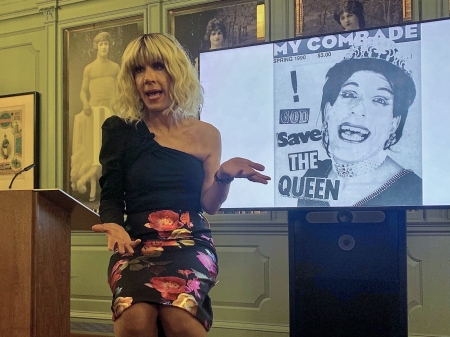Communications Intern Tess Kelley covered the Fall 2022 Hofer Lecture, featuring Linda Simpson, drag queen and founder and publisher of queer zine 'My Comrade.'
When drag performer Linda Simpson was brainstorming titles for her new queer zine, she wanted something “revolutionary.”
The goal was not necessarily to convey a political message — although, as it was the 1980s, she understood the very real veil of queer oppression of the time. Rather, Simpson wanted its title to sound tongue-in-cheek while fostering camaraderie. She settled on My Comrade.
Simpson was the featured speaker at the fall 2022 Philip and Frances Hofer Lecture at Houghton Library last month. Houghton acquired the publication records of My Comrade last year. Weaving in her account of New York’s queer scene at the time and thoughts on drag’s evolving status in popular culture, Simpson’s lecture recounted the process of conceptualizing and publishing the irreverent queer zine.

My Comrade, Simpson said, was fundamentally a humor magazine inspired by the “campy, ironic, and silly,” drag culture in New York’s East Village. It pondered what things would be like “if gay people ran the world” and cracked jokes at the expense of straight America, combining a healthy dose of humor with a critical look at the issues of the day faced by queer people. Its editorials, which were displayed on a screen behind Simpson as she spoke, featured drag queens and other queer people who flaunted queer pride and sexuality — including RuPaul, who was featured in the third issue.
In Simpson’s words, she wanted to create a zine that was “revolutionary, proud, and ultra-campy.”
Leaning into joy and extravagance was crucial given the time: as Simpson was creating My Comrade, the AIDS epidemic was decimating gay communities across the country. Portraying gay sexuality in a positive light, she explained, was a way eschew the grim association between sex and death caused by AIDS.
“It was about being sexy and strong in dangerous times,” she said.
My Comrade also brought joy to New York’s gay scene through its launch parties, some of which were thrown in Simpson’s own apartment. Her slideshow highlighted pictures of the walls covered floor-to-ceiling in painted words and beaming attendees dressed in their finest. It was also at these parties that Simpson herself first began to perform in drag.
After Simpson spoke, she stayed for a question-and-answer session led by Matthew Wittmann, curator of the Harvard Theatre Collection and Houghton Library’s current ‘American Drag’ exhibition. As the Hofer Lecture series was founded to focus on printing and graphic arts, Wittmann asked Simpson several questions about the publishing of My Comrade.
She described the zine's publishing as a scrappy DIY operation by a small group of queer New Yorkers; Simpson published its first issue herself on a “shoestring” budget in 1987, sneaking into the Xerox room of her temp job to print copies. In the age before computer layout, she would lay all the components of the pages on physical boards and print out tester copies to try out a certain arrangement. Color printing was too expensive for the zine’s budget, so everything was in black-and-white.
My Comrade’s initial run was composed of a total of 11 issues from 1987 to 1994, and two additional special issues were released in 2004 and 2006. While its publication schedule is not — and even in its initial run, Simpson explained, never had been — regular, she feels the zine “will never die.”
Asked by Wittmann about how drag was viewed in the 1980s, Simpson said, “the straight world didn’t know what to think,” while the gay community found it “old and dusty.” When drag began to expand in the 1990s — due to the influence of people like RuPaul, who brought an “East Village flair” to the art form — its queens became the most visible members of the gay community, as there were no out gay celebrities at the time.
As for drag today, while Simpson said she wishes there was more variety in the medium, she appreciates how much wider its popularity is than even a few years ago.
Over the course of the lecture and Q&A, the audience also heard from a reader of My Comrade who had snagged a copy during its initial run and a former model for the zine, both of whom were in attendance at Houghton over 20 years later. The camaraderie Simpson had aimed to create was manifested for the rest of the audience in the way My Comrade could still unite people decades later.